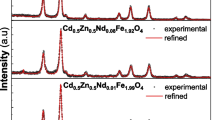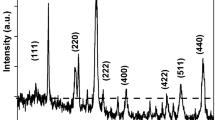Abstract
Three natural hematites, α-Fe2O3, from the region of Elba have been investigated by means of 57Fe Mössbauer spectroscopy at variable temperatures between 80 and 400K. The samples were selected on the basis of their different morphology as observed from powder X-ray diffraction and transmission electron microscopy. The mean crystallite diameters (MCD) along [104] are 1000, 280 and 40 nm respectively. Energy-dispersive analyses of X-rays revealed the presence of minor amounts of Si impurities in those two hematites having the largest MCD. All three hematites show the coexistence at low temperatures of antiferromagnetic-like (AF) and weakly-ferromagnetic-like (WF) spin states. The saturation values of the AF and WF magnetic hyperfine fields and quadrupole shifts have been determined, from which conclusions are drawn concerning the spin structure in relation to the crystallinity of the samples. The variations of the hyperfine parameters in the Morin-transition region indicate a gradual reorientation of both AF and WF spins towards the basal plane. As expected, the Morin transition itself is affected by the particle size. The two hematites exhibiting the largest particle dimensions still show an AF contribution for T>270K. It is suggested, and argued that this unusual behaviour is due to the presence of Si4+, and hence Fe2+, in the lattice. The characteristic Mössbauer temperatures and the intrinsic isomer shifts were evaluated from the temperature variation of the observed isomer shifts. Both parameters are not significantly affected by the morphology and are in excellent agreement with data obtained for synthetic hematites.
Similar content being viewed by others
References
Artman JO, Murphy JC, Foner S (1965) Magnetic anisotropy in antiferromagnetic corundum-type sesquioxides. Phys Rev 138:A912-A917
Besser PJ, Morrish AH, Searle CW (1967) Magnetocrystalline anisotropy of pure and doped hematite. Phys Rev 153:632–640
Coey JMD, Sawatzky GA (1971) A study of hyperfine interactions in the system (Fe1-xRhx)2O3 using the Mössbauer effect. J Phys C: Solid State Phys 4:2386–2407
De Grave E, Vochten R (1985) An 57Fe Mössbauer effect study of ankerite. Phys Chem Minerals 12:108–113
De Grave E, Bowen LH, Vochten R, Vandenberghe RE (1988a) The effect of crystallinity and Al substitution on the magnetic structure and Morin transition in hematite. J Magn Magn Mater 72:141–151
De Grave E, Bowen LH, Amarasiriwardena DD, Vandenberghe RE (1988 b) 57Fe Mössbauer effect study of highly substituted aluminum hematites: determination of the magnetic hyperfine field distributions. J Magn Magn Mater 72:129–140
De Grave E, Vandenberghe RE, Bowen LH (1990) Magnetic properties of some selected, soil-related iron oxides and oxyhydroxides as probed by 57Fe Mössbauer spectroscopy. In: Stanek J, Pedziwiatr AT (eds.) Proceedings of XXIV Zakopane School on Physics, vol. 2: Condensed Matter Studies by Nuclear Methods, World Scientific, Singapore, pp. 186–239
Duvigneaud PH, Derie R (1980) Shape effects on crystallite size distributions in synthetic hematites from X-ray line-profile analysis. J Solid State Chem 34:323–333
Eggleton RA, Schulze DG, Stucki JW (1988) Introduction to crystal structures of iron-containing minerals. In: Stucki JW, Goodman BA, Schwertmann U (eds.) Iron in Soils and Clay Minerals, D Reidel, Dordrecht, pp. 141–164
Ericsson T, Krisnhamurthy A, Srivastava BK (1986) Morin-transition in Ti-substituted hematite: a Mössbauer study. Phys Scripta 33:88–90
Flanders RJ, Remeika JP (1965) Magnetic properties of hematite single crystals. Phil Mag 11:1271–1288
Fritzsch E, Pietzsch C, Heegn H, Huhn H-J (1982) The Morin transition — a sensitive criterion for testing the quality of αFe2O3. Crystal Res Technol 17:1443–1447
Fysh SA, Clark PE (1982) Aluminous hematite: a Mössbauer study. Phys Chem Minerals 8:257–267
He T, Luo H-L, Li S (1988) Effect of Co on the Morin transition of hematite. J Magn Magn Mater 71:323–328
Heberle J (1971) The Debye Integrals, the thermal shift and the Mössbauer fraction. In: Gruverman U (ed.) Mössbauer Effect Methodology, vol. 7, Plenum Press, New York, pp 299–308
Jayasuriya KD, Stewart AM, Campbell SJ (1985) A specific heat study of natural haematite around the Morin transition and the effects of entrapped water. J Phys Chem Solids 46:625–629
Klug HP, Alexander LE (1974) X-ray Diffraction Procedures for Polycrystalline and Amorphous Materials, Wiley, New York, pp. 655–661
Krén E, Molnàr B, Svàb E, Zsoldos E (1974) Neutron diffraction study of the (1-x)αFe2O3-xAl2O3 system. Solid State Commun. 15:1707–1710
Kündig W, Bömmel H, Constabaris G, Lindquist RH (1966) Some properties of supported small α-Fe2O3 particles determined with the Mössbauer effect. Phys Rev 142:327–333
Liu JZ (1986) Morin transition in hematite doped with iridium ions. J Magn Magn Mater 54–57:901–902
Liu JZ, Fan CL (1984) Morin transition in the system of (1-x)Fe2O3-xRu2O3. Phys Lett 105A: 80–82
Morin FJ (1950) Magnetic susceptibility of α-Fe2O3 and α-Fe2O3 with added titanium. Phys Rev 78:819–820
Moriya T (1963) Weak Ferromagnetism. In: Rado GT, Suhl H (eds.) Magnetism, Vol. 1, Academic Press, New York, pp. 85–125
Murad E (1984) High-precision determination of magnetic hyperfine fields by Mössbauer spectroscopy using an internal standard. J Phys E: Sci Instrum. 17:736–737
Murad E, Johnston JH (1987) Iron oxides and oxyhydroxides. In: Long GJ (ed.) Mössbauer Spectroscopy Applied to Inorganic Chemistry, vol. 2, Plenum Press, New York, pp. 507–582
Naono H, Fujiwara R (1980) Micropore formation due to thermal decomposition of acicular microcrystals of α-FeOOH. J Colloid Interface Sci 73:406–415
Nininger RC Jr, Schroeer D (1978) Mössbauer studies of the Morin transition in bulk and microcrystalline α-Fe2O3. J Phys Chem Solids 39:137–144
Pankhurst QA, Johnson CE, Thomas MF (1986a) A Mössbauer study of magnetic phase transitions in α-Fe2O3 crystals. J Phys C: Solid State Phys 19:7081–7098
Pankhurst QA, Johnson CE, Thomas MF (1986b) Mössbauer measurements of the spin-flop transition in some α-Fe2O3 crystals. J Magn Magn Mater 54–57:1163–1164
Pound RV, Rebka GA Jr (1959) Gravitational red shift in nuclear resonance. Phys Rev Lett 3:75–76
Povitskii VA, Salugin AN, Makarov EF, Baldokhin YuV (1976) Mössbauer investigation of the magnetic structure of hematite containing a small amount of chromium. Sov Phys Solid State 18:958–959
Rendon JL, Cornejo J, De Arambarri P, Serna CJ (1983) Pore structure of thermally treated goethite (α-FeOOH). J Colloid Interface Sci 92:508–516
Schwertmann U, Fitzpatrick RW, Taylor RM, Lewis DG (1979) The influence of aluminium on iron oxides. Part II. Preparation and properties of Al-substituted hematites. Clays Clay Minerals 27:105–112
Tobler L, Kündig W, Savic I (1981) Investigation of the Morin transition in α-Fe2O3 by the Mössbauer effect. Hyperfine Interactions 10:1017–1022
Van Alboom A, De Grave E (1991) Temperature dependence of the Mössbauer effect in synthetic ferri-diopsides (in preparation)
Vandenberghe RE, Verbeeck AE, De Grave E, Stiers W (1986) 57Fe Mössbauer effect study of Mn-substituted goethite and hematite. Hyperfine Interactions 29:1157–1160
Vandenberghe RE, De Grave E, Landuydt C, Bowen LH (1990) Some aspects concerning the characterization of iron oxides and hydroxides in soils and clays. Hyperfine Interactions (in press)
van der Kraan AM (1972) Mössbauer effect studies of superparamagnetic α-FeOOH and α-Fe2O3. PhD Thesis, Technische Hogeschool Delft, The Netherlands, pp. 1–121
van der Woude F (1966) Mössbauer effect in α-Fe2O3. Phys Status Solidi 17:417–432
Verbeeck AE, De Grave E, Vandenberghe RE (1986) The effect of the particle morphology on the Mössbauer effect in α-Fe2O3. Hyperfine Interactions 28:639–642
Watari F, Van Landuyt J, Delavignette P, Amelinckx S (1979) Electron Microscopic study of dehydration transformations. I. Twin formation and mosaic structure in hematite derived from goethite. J Solid State Chem 29:137–150
Zalesskii AV, Krivenko VG, Lutovinov VS, Murashov VA, Khimich TA (1989) NMR study of the supertransferred hyperfme fields at 57Fe nuclei and Morin transition in Al-substituted hematite crystals. Phys Status Solidi (b) 155:K63-K66
Author information
Authors and Affiliations
Rights and permissions
About this article
Cite this article
De Grave, E., Vandenberghe, R.E. Mössbauer effect study of the spin structure in natural hematites. Phys Chem Minerals 17, 344–352 (1990). https://doi.org/10.1007/BF00200130
Received:
Issue Date:
DOI: https://doi.org/10.1007/BF00200130




